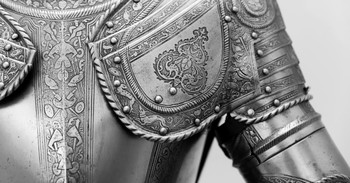
On this day, May 28, 1588, Medina Sidonia's flagship, the San Martin led the greatest fleet ever assembled up to that time, out of the Lisbon River to sea. They were bound for England. Philip, King of Spain, had had enough of the pesky English, who pretended to be at peace with him while waging war. Above all, the Spanish loathed Sir Francis Drake, who harried and harassed them at sea and along their coasts in Europe and Latin America.
There were religious reasons for the attempted invasion, too. Spain was Catholic, England Protestant. Nothing would please the Spanish empire more than to return the island nation to the Roman fold. Its policy had been aimed at this for decades.
Aboard the 130 newly-outfitted ships of the Armada were 19,000 soldiers, ready to invade and conquer England. But from the start, the Spanish fleet experienced difficulties. Its ships met bad weather. Getting so many ships with unequal abilities into formation proved difficult. Furthermore, Drake's bold attack on Cadiz in 1587 had delayed the invasion a year. More importantly, Drake had burned vast quantities of wood and hoops intended to make barrels. As a result of this and of having eaten its freshest supplies over winter, the Armada found itself with spoiled rations. Plague began. The ships had to regroup at Finnisterre and deal with these problems. It cost them a month's delay.
Drake wanted to attack the Spanish in their own waters. Elizabeth said no. She did not want to commit her nation to war. Drake brought the fleet into Portsmouth harbor. The wind turning, it was almost trapped there. But the English captains quickly "warped" out (hauled their ships around on anchors). Sailing under Philip's inflexible orders, the Spanish missed a golden opportunity to seriously maul the English fleet.
The English strategy proved flawed when they harassed the Spanish from a distance: shells from the long range guns to which they had committed their fleet could not penetrate the Spanish hulls. The Spanish formation, briefly impaired by storms, remained substantially intact and arrived in the straits of Dover, on August 6th, more than two months after setting sail.
The English launched fireboats against the Spanish, who panicked and broke formation trying to get free. The Armada, harassed by the English and Dutch, put up a fight, but when its shot ran out, the English sailed in close and began pounding the big ships to pieces. Attempting to stick together, the Armada sailed in the only direction it could go: north. The sailors attempted to take their ships around Scotland and back down the Atlantic past Ireland home. At least 51 ships perished and thousands of men.
The defeat of the Armada helped preserve the Reformation. Philip, when he heard of the magnitude of the disaster wrote, "I hope that God has not permitted so much evil for everything has been done in his service." But Protestants issued gloating letters, pamphlets and medals. "God breathed and they were scattered," said one of Elizabeth's medals.
Bibliography:
- "Armada." Encyclopedia Britannica. Encyclopedia Britannica, 1968.
- Martin, Colin and Parker, Geoffrey. The Spanish Armada. New York: Norton, 1988.
- Mattingly, Garrett. The Armada. Boston: Houghton, Mifflin, 1959.
Last updated July, 2007


